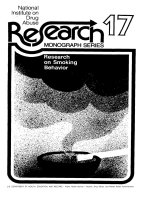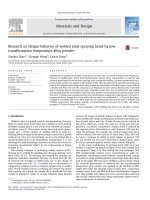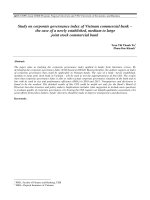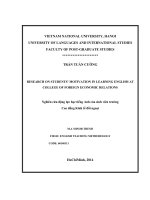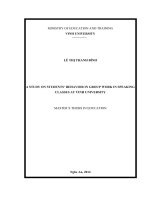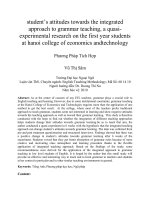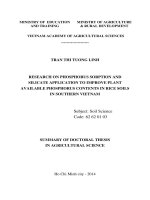Research on antisocial behavior at UPS vietnam
Bạn đang xem bản rút gọn của tài liệu. Xem và tải ngay bản đầy đủ của tài liệu tại đây (2.01 MB, 59 trang )
Business Research Method Assignment 2016
MASTER OF BUSINESS ADMINISTRATION
RESEARCH PROJECT
(BMBR5103)
RESEARCH ON ANTISOCIAL BEHAVIOR
AT UPS VIETNAM
ADVISOR’S NAME & TITLE:
NGUYEN THE KHAI, DBA
STUDENT’S FULL NAME:
NGUYEN DINH HOA
STUDENT ID:
CGS00019373
INTAKE:
MARCH 2015
Page 0
Nguyen Dinh Hoa
AUGUST 2016
Business Research Method Assignment 2016
MASTER OF BUSINESS ADMINISTRATION
RESEARCH PROJECT
(BMBR5103)
RESEARCH ON ANTISOCIAL BEHAVIOR
AT UPS VIETNAM
ADVISOR’S NAME & TITLE:
NGUYEN THE KHAI, DBA
STUDENT’S FULL NAME:
NGUYEN DINH HOA
STUDENT ID:
CGS00019373
INTAKE:
MARCH 2015
AUGUST 2016
Nguyen Dinh Hoa
Page 1
Business Research Method Assignment 2016
ADVISOR’S ASSESSMENT
.......................................................................................................................................................
.......................................................................................................................................................
.......................................................................................................................................................
.......................................................................................................................................................
.......................................................................................................................................................
.......................................................................................................................................................
.......................................................................................................................................................
.......................................................................................................................................................
.......................................................................................................................................................
.......................................................................................................................................................
.......................................................................................................................................................
.....................................................................................................................................................
ADVISOR’S SIGNATURE
AUGUST 2016
NGUYEN THE KHAI, DBA
Nguyen Dinh Hoa
Page 2
Business Research Method Assignment 2016
ACKNOWLEDGEMENT
It is with greatest veneration and respect, I would like to extend my sincere thanks to Dr. Nguyen
The Khai for his dedicated lectures during the last semester of OUM MBA program at HUTECH
University. I have gained a lot of knowledge of Business Research Method and it is beneficial to the
development of my career and studies in the future. And with Dr. Khai’s valuable guidance and
supervision, I have completed my first research project in my life - A research on antisocial behavior
at UPS Vietnam.
I would like to express my appreciation to managers, supervisors and employees who are working in
different departments at UPS Vietnam for providing me necessary data to carry out this research
successfully.
Lastly, this research would not have been completed without the support and motivation from my
beloved family, lecturers, classmates and friends who has been with me through thick and thin
during the time I have been pursuing this MBA program.
Ho Chi Minh City, August 1st, 2016
NGUYEN DINH HOA
Nguyen Dinh Hoa
Page 1
Business Research Method Assignment 2016
ABSTRACT
One of the most studied areas within the field of human resource management that has received
considerable interest in the literature recently is antisocial behavior. Although several environmental
variables have been related to the development of antisocial behavior, this research has focused on
some factors that would increase the probability of engaging in antisocial behavior including
satisfaction with my supervisor, control & complexity, social support and job stress scale.
This study hopes to understand why employees engage in high levels of antisocial behavior across
time and context. The term antisocial behavior refers to disruptive behaviors, most often aggressive,
that have in common transgressions against social norms. The purpose of this research is to help
managers of organizations understand the factors associated with antisocial behavior. The
interpretation of collected data will be followed by the researcher’s discussion and
recommendations.
In spite of unavoidable limitations, the outcomes of this research are expected to be a possibly
constructive source for managers to refer in coming up with interventions dealing with antisocial
behaviors in organizations.
Nguyen Dinh Hoa
Page 2
Business Research Method Assignment 2016
Table of Content
ACKNOWLEDGEMENT...................................................................................................................1
ABSTRACT..........................................................................................................................................2
PART I: INTRODUCTION..................................................................................................................8
1. About UPS Vietnam..............................................................................................................8
2. Motivation of the Research..................................................................................................16
3. Research Objective..............................................................................................................17
4. Research Scope....................................................................................................................17
5. Significance of Research.....................................................................................................18
6. Limitation of Research........................................................................................................18
PART II: LITERATURE REVIEW....................................................................................................19
1. Antisocial Behavior.............................................................................................................19
2. Satisfaction with My Supervisor........................................................................................19
3. Control & Complexity.........................................................................................................20
4. Social Support......................................................................................................................21
5. Job Stress Scale...................................................................................................................22
PART III: RESEARCH MODEL AND HYPOTHESES....................................................................24
1. Research Model...................................................................................................................24
Nguyen Dinh Hoa
Page 3
Business Research Method Assignment 2016
1.1 Dependent Variables..............................................................................................24
1.2 Independent Variables...........................................................................................25
2. Research Hypotheses...........................................................................................................26
2.1. Satisfaction with My Supervisor (H1)..................................................................26
2.2. Control and Complexity (H2)...............................................................................26
2.3 Social Support (H3)...............................................................................................27
2.4. Job Stress Scale (H4)............................................................................................27
3. Instruments..........................................................................................................................28
4. Research Participants...........................................................................................................28
5. Procedure for Data Collection and Analysis.......................................................................29
5.1. Data Collection Progress......................................................................................29
5.2. Data Analysis........................................................................................................30
PART IV: RESULTS and FINDINGS................................................................................................31
1. Reliability Analysis.............................................................................................................31
2. Descriptive Analysis............................................................................................................33
3. Correlation of all Variables Statistics..................................................................................33
4. Hypothesis Testing..............................................................................................................34
4.1. Hypothesis 1 Testing Result.................................................................................35
4.2. Hypothesis 2 Testing Result.................................................................................36
Nguyen Dinh Hoa
Page 4
Business Research Method Assignment 2016
4.3. Hypothesis 3 Testing Result.................................................................................37
4.4. Hypothesis 4 Testing Result.................................................................................37
PART V: DISCUSSION.....................................................................................................................39
1. Key Findings and Implications............................................................................................39
2. Limitations...........................................................................................................................40
REFERENCES....................................................................................................................................42
APPENDIX A: Antisocial Behavior Survey at UPS Vietnam............................................................45
APPENDIX B: Research Project Presentation....................................................................................50
Nguyen Dinh Hoa
Page 5
Business Research Method Assignment 2016
List of Figures and Tables
Figure 1: UPS Corporation Organization Structure.............................................................................10
Figure 2: UPS Vietnam JSC Service Portfolio....................................................................................13
Figure 3: UPS Vietnam JSC Air Freight Outbound Network.............................................................15
Figure 4: UPS Vietnam JSC Ocean Outbound Transit Time..............................................................16
Figure 5: Proposed Research Model of Antisocial Behavior at UPS Vietnam...................................24
Table 1: UPS Global Presence...............................................................................................................8
Table 2: UPS Vietnam JSC Operating Locations................................................................................12
Table 3: UPS Vietnam JSC Retail Access Points................................................................................12
Table 4: UPS Vietnam JSC Enhanced Services & Technology..........................................................14
Table 5: UPS Vietnam JSC Key Export Countries & Commodities...................................................14
Table 6: UPS Vietnam JSC Key Import Countries & Commodities...................................................15
Table 7: Time table for Data Collecting Progress...............................................................................29
Table 8: Cronbach’s Alpha – Internal Consistency.............................................................................31
Table 9: Reliability Test for Satisfaction with My Supervisor (SMS)................................................31
Table 10: Reliability Test for Control & Complexity (CC)................................................................32
Table 11: Reliability Test for Social Support (SS)..............................................................................32
Table 12: Reliability Test for Job Stress Scale (JSS)..........................................................................32
Nguyen Dinh Hoa
Page 6
Business Research Method Assignment 2016
Table 13: Reliability Test for Antisocial Behavior (AB)....................................................................33
Table 14: Descriptive Statistics...........................................................................................................33
Table 15: Correlation Statistics...........................................................................................................34
Table 16: Model Summary of H1........................................................................................................35
Table 17: Coefficient of H1.................................................................................................................35
Table 18: Model Summary of H2........................................................................................................36
Table 19: Coefficient of H2.................................................................................................................36
Table 20: Model Summary of H3........................................................................................................37
Table 21: Coefficient of H3.................................................................................................................37
Table 22: Model Summary of H4........................................................................................................38
Table 23: Coefficient of H4.................................................................................................................38
Nguyen Dinh Hoa
Page 7
Business Research Method Assignment 2016
PART I: INTRODUCTION
1. About UPS Vietnam.
United Parcel Service (UPS), Inc. is the world's largest package delivery company and a
provider of supply chain management solutions. The global logistics company is headquartered in
Sandy Springs, Georgia, which is part of the Greater Atlanta metropolitan area. UPS delivers more
than 1.5 million packages a day to more than 7.9 million customers in more than 220 countries and
territories around the world. UPS is known for its brown delivery trucks and uniforms, hence the
company nickname "Brown". UPS also operates its own airline and air cargo delivery service based
in Louisville, Kentucky.
On August 28, 1907, James Casey founded the American Messenger Company with fellow
teenager Claude Ryan in Seattle, Washington, capitalized with $100 in debt. In 1913, the first
delivery car appeared, a Model T Ford. Casey and Ryan merged with a competitor, Merchants Parcel
Delivery. Consolidated delivery was also introduced, combining packages addressed to a certain
neighborhood onto one delivery vehicle. In 1930, a consolidated service began in New York City,
and soon after in other major cities in the East and the Midwest. In 1937, the logo was redesigned to
reflect the company's new name United Parcel Service. From 1940, the company acquired "common
carrier" rights to deliver packages between all addresses, any customer, private and commercial. In
1991, UPS moved its headquarters to Sandy Springs, Georgia, a suburb of Atlanta. On November
10, 1999, UPS became a public company.
UPS GLOBAL PRESENCE
Type
Public Company
Traded as
NYSE: UPS
Industry
Courier
Nguyen Dinh Hoa
Page 8
Business Research Method Assignment 2016
Founded
August 28, 1907 in Seattle, Washington, USA
Founder
James E. Casey
Headquarters
Atlanta, Georgia, USA
Key people
Key services
Scott Davis (Chairman)
David Abney (CEO)
Logistics and transportation of parcel and freight
through air, ocean, ground and rail
2014 Revenue
US$ 58.232 billion
Number of employees
401,000 (318,000 in US and 83,000 International)
Key services
Logistics and transportation of parcel and freight
through air, ocean, ground and rail
Service area
More than 220 countries and territories
UPS jet aircraft
237 in service
Daily flight segments
Domestic – 940; International – 1,015
Operating facilities
Customers
Subsidiaries
Nguyen Dinh Hoa
1,990 for package
528 for supply chain (30.9 million sq. ft.)
213 service centers for freight
9.4 million daily
The UPS Store
UPS Supply Chain Solutions
UPS Capital
UPS Airlines
UPS Express Critical
UPS Freight
UPS Logistics
UPS Mail Innovations
UPS i-Parcel
Page 9
Business Research Method Assignment 2016
Worldwide web address
www.ups.com
Table 1: UPS Global Presence
Organization Structure
Figure 1: UPS Corporate Organization Structure
Name
Nguyen Dinh Hoa
Current Position
Since
Age
David Abney
Chief Executive Officer
2014
60
Richard Peretz
Chief Financial Officer
2015
53
Teri McClure
Chief HR Officer, Senior VP
2016
51
Alan Gershenhorn
Executive VP and CCO
2014
57
Page 10
Business Research Method Assignment 2016
David Barnes
Senior VP, CIO
2005
59
Kate Gutmann
Senior VP, Worldwide Sales
2014
46
James Barber
Senior VP, UPS International
2013
54
Teresa Finley
Senior VP, Global Marketing
2015
53
Myron Gray
Senior VP, US Operations
2009
57
Mark Wallace
Senior VP, Engineering
2015
52
UPS Vietnam JSC
UPS Inc. leveraged its world-class service and cutting edge technology to bring UPS closer to
business in Vietnam to help enhance the connectivity of Vietnamese businesses to the global market.
In April 1994, it signed agent contracts with Ho Chi Minh City P&T and Hanoi P&T. From 2010,
UPS expanded its footprint in Vietnam through a joint stock company (JSC) to expand operations in
Vietnam. Through this JSC, UPS invested in new facilities in key commercial and industrial centers
across Vietnam to widen access to growing capability and connect to the global UPS network.
UPS Vietnam JSC is extending its express delivery service to all 63 provinces in Vietnam and
offer later pick-up and cut-off times. UPS’s Intra-Asian and global network gives Vietnam
businesses access to over 220 countries and territories worldwide. UPS’s innovative technology
enables Vietnam businesses to streamline their shipping operations for greater efficiency and ease.
For example, UPS Paperless Invoice reduces customs delays and improves productivity by
eliminating redundant data entry.
In 2013, UPS Vietnam JSC became the first 100%-owned foreign company operating in express
delivery service industry.
Nguyen Dinh Hoa
Page 11
Business Research Method Assignment 2016
UPS Vietnam JSC Operating Locations
Table 2: UPS Vietnam JSC Operating Locations
UPS Vietnam JSC Retail Access Points
Table 3: UPS Vietnam JSC Retail Access Points
Nguyen Dinh Hoa
Page 12
Business Research Method Assignment 2016
UPS Vietnam JSC Service Portfolio
Figure 2: UPS Vietnam JSC Service Portfolio
Nguyen Dinh Hoa
Page 13
Business Research Method Assignment 2016
UPS Vietnam JSC Enhanced Services & Technology
Table 4: UPS Vietnam JSC Enhanced Services & Technology
UPS Vietnam JSC Key Export Countries & Commodities
Table 5: UPS Vietnam JSC Key Export Countries & Commodities
Nguyen Dinh Hoa
Page 14
Business Research Method Assignment 2016
UPS Vietnam JSC Key Import Countries & Commodities
Table 6: UPS Vietnam JSC Key Import Countries & Commodities
UPS Vietnam JSC Air Freight Outbound Network
Figure 3: UPS Vietnam JSC Air Freight Outbound Network
Nguyen Dinh Hoa
Page 15
Business Research Method Assignment 2016
UPS Vietnam JSC Ocean Outbound Transit Time
Figure 4: UPS Vietnam JSC Ocean Outbound Transit Time
2. Motivation of the Research
Vietnam has exhibited as one of the countries with highest rates of economic growth and poverty
reduction in the region and in the world. Vietnam has been able to sustain this progress for over two
decades thanks to the effective implementation of economic reform policies. One of the most
important factors that has helped Vietnam grow its national economy is ability to consistently attract
foreign direct investment (FDI). A strong sense of social solidarity and equity has also contributed to
effective policy and implementation, as well as continued investment in human development,
leading to significant improvements in human capital, thus enabling people to take advantage of
market opportunities.
Joining Trans Pacific Partnership (TPP) has brought more opportunities to increase trading
activities for Vietnam, and it is especially good for delivery companies doing business in Vietnam.
UPS Vietnam is a 100% FDI-company. It is one of the top companies that provides delivery services
in Vietnamese market currently with average annual growth rate approximately 40%. Due to the
Nguyen Dinh Hoa
Page 16
Business Research Method Assignment 2016
growing, the company is increasing its labor force and the need to retain the employees has become
one of the most important tasks of company managers.
Along with sound policies on compensation, training and developing, and retain the people,
managers at UPS Vietnam also realize the importance of understanding employees’ antisocial
behaviors to prevent potential harm to individuals and/or the company as well as creating a good
working environment for its employees.
3. Research Objective
The purpose of this research is to investigate the impact of satisfaction with my supervisor,
control & complexity, social support and job stress scale on UPS Vietnam’s employee antisocial
behavior.
This research includes three phases as follows.
Phase 1: search related information and try to define what antisocial behavior means at
UPS Vietnam.
Phase 2: come up with a research model and test related factors to examine influence
between factors to antisocial behaviors at UPS Vietnam.
Phase 3: discussing and proposing recommendation to managers at UPS Vietnam to
improve the effectiveness of preventing employees’ antisocial behavior.
4. Research Scope
The scope of this research is for the entire employees at UPS Vietnam, including company
managers, supervisors and employees working in all department at UPS Vietnam subsidiary. The
research does not include the employees who are under probation period or on maternity leave.
The contents of this research include only factors that influence the antisocial behaviors and are
limited to determine the perception of the respondents on satisfaction with supervisors, control &
complexity, social support and job stress scale.
Nguyen Dinh Hoa
Page 17
Business Research Method Assignment 2016
5. Significance of Research
The impact of antisocial behavior is emerging as a critical issue on organizational performance
and attract many researches in HRM field.
This study is significant for human research management in logistics industry. Findings of this
research will be helpful to managers at UPS Vietnam to be aware of the importance of antisocial
behavior, to examine the success of human resource practices and to assist them in improving the
effectiveness of labor force by managing human resource matters efficiently and effectively. Besides
supporting effective management, this research also helps improve employee’s loyalty to the
organization and encourage employee to contribute to the company growth.
6. Limitation of Research
Although this research was well prepared and instructed by dedicated lecturer, it has also some
limitations because the survey was conducted in a short period of time and only focus on UPS
Vietnam employees, so it cannot generalize for the whole logistics industry. In addition, the
language was used in the questionnaire is only English and it can create confusion for the
respondents.
Nguyen Dinh Hoa
Page 18
Business Research Method Assignment 2016
PART II: LITERATURE REVIEW
1. Antisocial Behavior:
The prevention of antisocial actions in organizations is increasingly important to managers and
organizational scholars since there is a good reason for them to have a closer view on these actions.
Some researches show that as many as 42% of women have been victims of sexual harassment at
work (Gruber, 1990), as many as 75% of employees have stolen from their employers (McGurn,
1988), and that 33% to 75% of all employees have engaged in behaviors ranging from
insubordination to sabotage (Harper, 1990). These actions stand for some of the most serious forms
of antisocial behavior.
Initial researches in this area have been used different names to depict these action. For instance,
deviant behavior (Robinson and Bennett, 1995), aggressive work behavior (O’Leary-Kelly, Griffin,
and Glew, 1996), and organizational misbehavior (Vardi and Wiener, 1996). In the area of this
research, however, I use the broad term “antisocial behavior” to depict negative behaviors in firms
since it captures a wide range of actions and also catches the harmful nature of these acts. The fact
that they have the potential to cause harm to individuals and/or the property of an organization
(Giacalone & Greenberg, 1996). This dimension of potential harmfulness is the critical focus of
most definitions of related constructs (Robinson and Greenberg, 1998).
Currently, antisocial behaviors in firms have been examined from diverse theoretical
perspectives. For instance, applying social learning theory (Bandura, 1977), identified a number of
individual and environmental antecedents (O’Leary-Kelly et al.), working on theft (Greenberg’s,
1990), researching on retaliation (Skarlicki and Folger’s, 1997). These well-grounded in established
theory approaches have resulted in crucial progresses in apprehending of why and when employees
commit in antisocial behavior.
2. Satisfaction with My Supervisor
Nguyen Dinh Hoa
Page 19
Business Research Method Assignment 2016
Training & development directors, HR managers, and corporate executives agree that the
supervisors play an important role in managing organizations (Bittel & Ramsey, 1983; Walker &
Gutteridge, 1979). The involvement of supervisory in career planning and development of a
subordinate is a key factor in the effectiveness of career planning and development programs of
organizations (Walker & Gutteridge, 1979). Finally, experts in labor relations agree that a positive
relationship between a supervisor and a subordinate is a necessary condition for the effectiveness of
an union-management relationship (Stepp, Baker, & Barrett, 1982). Research of behavioral in labor
relations also shows that along with compensation package, fringe benefits, and the security of job,
dissatisfaction with one’s supervisor is a main reason of unionization (Getman, Goldberg, &
Herman, 1976). Moreover, in a research completed with nearly 88,000 sales, and technical staff of
Sears & Roebuck, Hamner & Smith (1978) found that the strongest forecaster of unionization
attempts was the dissatisfaction of employees to their immediate supervisors.
3. Control & Complexity
Many theories and researches within organizational behavior and industrial and organizational
psychology suggest that characteristics of work influence the attitudes and behaviors of an
individual. Employee’s motivation is affected by characteristics of work (Hackman & Oldham,
1976), they are also socialized by characteristics of work (occupational socialization; Frese, 1982)
and by management (organizational socialization; Van Maanen, 1976), and they are trained to fulfill
the job (Latham, 1989).
Work characteristics should include an effect on control orientation. More specifically speaking,
control aspirations are reduced by lack of control, as suggested by the helplessness model (Seligman,
1975). Lack of options and thwarting control leads to helplessness which produces negative
motivational consequences because the organism stops trying to control the environment when it
does not expect any positive outcomes (Heckhausen & Schulz, 1995; Rothbaun et al., 1982;
Seligman, 1975). Abramson, Seligman, and Teasdale (1978) have shown that helplessness can be
broadly generalized. The helplessness effect appears even if there are short-lived opposite effects as
well, such as the reactance effect: Wortman and Brehm (1975) combined reactance and helplessness
theories by showing that in the short term, lack of control and options increase aspiration for control,
as reactance theory suggests. However, if attempts to increase control and options get thwarted over
Nguyen Dinh Hoa
Page 20
Business Research Method Assignment 2016
a Personal Initiative 10 long period of time, learned helplessness develops - thus, in the long run,
reduced control aspirations result.
The complexity of job, on the other hand, put high demand on workers’ skills for a variety of
reasons (Wood, 1986). Strain may derive from the number of tasks and number of decisions required
(Wood, 1986; Jovanovic et al., 1995), from the uncertainty characterizing causal relationship or
expected outcomes from choices and often the number or types of alternative courses of action
(March and Simon, 1958), from the informational needs linked to problem solving involving finding
solutions to complex problems (Payne, 1976; Campbell and Gingrich, 1986; Hunter, 1986; Sweller,
1988; van Merriënboer and Sweller, 2005), or from the need to use and integrate information from
many different source (Steinmann, 1976). Learning will take place while workers face these
challenges and master them (Anzai and Simon, 1979; Eraut, 2004; Berings et al., 2005; Pankhurst,
2010); through the efforts devoted to find effective solutions to problems arising from non-routine
work situations. Work itself then becomes a source of learning (Jovanovic et al., 1995).
If jobs put strain on workers’ skills and afford broad learning opportunities organizations may
become learning environments in which human capital can support the product market strategy and
can be regarded as a firm-level resource conferring some degree of competitive advantage (Boxall
and Purcell, 2011; Ployhart and Moliterno, 2011; Beaudry et al., 2013; Sterling and Boxall, 2013;
Sung and Ashton, 2015). The Resource Based View (RBV) posits that the knowledge and the skills
accumulated within organisations are rare (specific), valuable, and hard to imitate (Barney, 2001;
Hult et al., 2005; Ketchen et al., 2007). They are an intangible asset for the organization (Beaudry et
al., 2013), one that contributes to organisational success (Molloy et al., 2011; Smithey Fulmer and
Ployhart, 2014). The link between human capital and business success is known to managers; they
rank know-how and knowledge as the second most important intangible assets after the reputation of
the organisation or of the product (brand asset). Managers are also keenly aware of the time needed
to build human capital and that the capital is subjected to depreciation: managers estimate that it
takes about 5 years to build a satisfactory knowledge base (Hall, 1992) and consider training
(investment in human capital) to remain valid for about 3 years (Awano et al., 2010).
4. Social Support
Nguyen Dinh Hoa
Page 21
Business Research Method Assignment 2016
There is an increasingly number of researches not only examining formal human resource
policies but also informal perceptions of employees of support at work. For instance, early work–
family (W–F) research emphasized how employees’ access and use of formal workplace supports
(i.e., work–family policies, such as on site child care) can reduce work–family conflict (e.g., Goff,
Mount, & Jamison, 1990; Kossek & Nichol, 1992), in recent years, the field has shifted to
emphasize informal workplace support, such as a supervisor sympathetic to work–family issues
(Hammer, Kossek, Yragui, Bodner & Hanson, 2009; Thomas & Ganster, 1995) or a positive work–
family organizational climate (Allen, 2001).
To date, many new human resource management trends heightening workplace stress have made
it crucial for psychologists and managers to better understand informal workplace social support
connections to work–family conflict. These include changing labor market demographics to involve
more workers that value work–life flexibility; rising work hours and workloads distributed on 24–7
operating systems, sharpening the pace and intensity of work; and escalating financial, market and
job insecurity from the global economy (Kossek & Distelberg, 2009).
The concept of workplace social support is derived from the broader social-support literature. It
is typically viewed as a global construct (House, 1981) with a range of definitional dimensions that
fluctuate in meaning. One of the most widely used and earliest definitions comes from Cobb (1976),
who defined social support as an individuals’ belief that she is loved, valued, and her well-being is
cared about as part of a social network of mutual obligation. Others have viewed social support as
involving perceptions that one has access to helping relationships of varying quality or strength,
which provide resources such as communication of information, emotional empathy, or tangible
assistance (Viswesvaran, Sanchez, & Fisher, 1999). Workplace social support is defined as the
degree to which individuals perceive that their well-being is valued by workplace sources, such as
supervisors and the broader organization in which they are embedded (Eisenberger, Singlhamber,
Vandenberghe, Sucharski, & Rhoades, 2002; Ford et al., 2007), and the perception that these sources
provide help to support this well-being.
5. Job Stress Scale
Nguyen Dinh Hoa
Page 22
